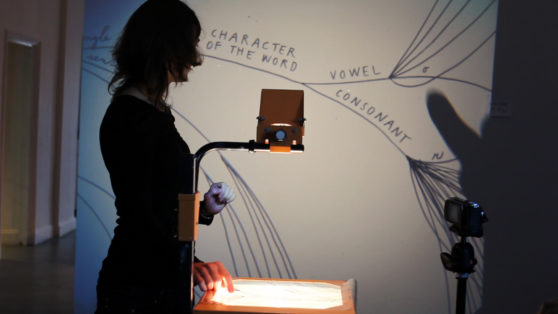MAGDA STANOVA
- ART & SCIENCE
* 1981 Prešov, Slovak Republic, lives and works in Praha (Prague) Czech Republic.
artist
In collaboration with the Campus Biotech and Flux Laboratory
Magda Stanová is an artist interested in analyses of creative processes and perception of art, theory of photography, as well as urban development and cartography especially from the point of view of a pedestrian. Her research-based practice results in artistic forms like visual essays and lecture-like events. She authored two books—Algorithms in Art (2016) and W cieniu fotografii (2008)—and coauthored the publication The Pedestrian’s Venice (2017). She holds an MFA in photography from the Academy of Fine Arts and Design in Bratislava, an MFA in new genres from the San Francisco Art Institute, where she studied as a Fulbright scholar, and a PhD in fine arts from the Academy of Fine Arts in Prague.
Statement
When the allure of a cave seems not enough.
A repeated joke isn’t funny, but looking at the night sky seems to impress us every time. A metaphor often turns into a cliché, but sometimes it becomes a regular term. Why do some experience triggers wear off more slowly than others?
And what happens when two or more triggers of various fade rate are mixed together? Guided tours through caves are designed in a way as if the beauty of a cave was not enough. Thus, they include legends, interpretative names for walls and rooms, colourful lights, music, and the possibility to throw a coin into a puddle to make a wish. While some such combinations of triggers enhance the experience, others may diminish it or even destroy it. In this project, I study experience triggers from various genres that combine different types of emotions—which combinations augment the experience and which of them are counter-productive? How does this combined effect change over time?
During the residency, I will discuss these and other related topics with the scientists from the Campus Biotech. I will combine the findings with my observations in the form of short texts and drawings, which will serve as a groundwork for a book on which I will work after the residency. The book will be both an artist’s book and an art theory book at the same time. I imagine it as a kind of a textbook for (primarily, but not only) art students, like Paul’s Klee Pedagogical Sketchbook, but with knowledge and understanding which, since his time, were brought forth by scientific research in cognitive sciences.
Lecture-inspired mind wondering
When a lecturer says something that sparks our thinking, we stop paying attention, start our own line of thoughts, and inevitably miss some part of the lecture. (Similar thing can happen when a lecture is too boring or too complex.) In collaboration with the scientists from the Human Neuroscience Platform, I will try to monitor lecture-inspired mind wondering. I will first try it on me, and then with more people during a performative lecture in which I will talk about this problem. Based on the collected data, I plan to make drawings about how the attention of the members of the audience diverges and converges with that of the lecturer.
www.magdastanova.sk
https://www.researchcatalogue.net/view/1223446/1223447
What happens in the brain when we are reading scientific papers?
There have been many studies focused on what happens in the brain when we are looking at art or are listening to music. But it might be also interesting to look into what happens in the brain when we are reading scientific papers. Designing such study could reveal something about similarities and differences in perceiving the outcomes of artistic and scientific work.

Year

